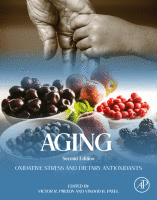Browse content
Table of contents
Actions for selected chapters
- Full text access
- Book chapterNo access
Index
Pages 375-382
About the book
Description
Aging: Oxidative Stress and Dietary Antioxidants, Second Edition, bridges the trans-disciplinary divide and covers the science of oxidative stress in aging and the therapeutic use of natural antioxidants in the food matrix in a single volume. The second edition covers new trials and investigations used to determine the comprehensive properties of antioxidants, food items and extracts, as well as any adverse properties they may have. It has been updated to include new clinical human trials and a new section dedicated to animal models of aging. Throughtout the book the processes within the science of oxidative stress are described in concert with other processes, such as apoptosis, cell signaling, and receptor mediated responses. This approach recognizes that diseases are often multifactorial, and oxidative stress is a single component of this.
Gerontologists, geriatricians, nutritionists, and dieticians are separated by divergent skills and professional disciplines that need to be bridged to advance preventative as well as treatment strategies. While gerontologists and geriatricians may study the underlying processes of aging, they are less likely to be conversant in the science of nutrition and dietetics. On the other hand, nutritionists and dietitians are less conversant with the detailed clinical background and science of gerontology. This book addresses this gap and brings each of these disciplines to bear on the processes inherent in the oxidative stress of aging. This will aid in better research, treatment and outcome for patients.
Aging: Oxidative Stress and Dietary Antioxidants, Second Edition, bridges the trans-disciplinary divide and covers the science of oxidative stress in aging and the therapeutic use of natural antioxidants in the food matrix in a single volume. The second edition covers new trials and investigations used to determine the comprehensive properties of antioxidants, food items and extracts, as well as any adverse properties they may have. It has been updated to include new clinical human trials and a new section dedicated to animal models of aging. Throughtout the book the processes within the science of oxidative stress are described in concert with other processes, such as apoptosis, cell signaling, and receptor mediated responses. This approach recognizes that diseases are often multifactorial, and oxidative stress is a single component of this.
Gerontologists, geriatricians, nutritionists, and dieticians are separated by divergent skills and professional disciplines that need to be bridged to advance preventative as well as treatment strategies. While gerontologists and geriatricians may study the underlying processes of aging, they are less likely to be conversant in the science of nutrition and dietetics. On the other hand, nutritionists and dietitians are less conversant with the detailed clinical background and science of gerontology. This book addresses this gap and brings each of these disciplines to bear on the processes inherent in the oxidative stress of aging. This will aid in better research, treatment and outcome for patients.
Key Features
- Compares information related to mitochondrial oxidative stress in one disease to diet-related strategies in other unrelated diseases
- Provides an understanding of cell signalling leading to new suggestions of preventative or therapeutic strategies
- Includes a new section dedicated to animal models of aging
- Compares information related to mitochondrial oxidative stress in one disease to diet-related strategies in other unrelated diseases
- Provides an understanding of cell signalling leading to new suggestions of preventative or therapeutic strategies
- Includes a new section dedicated to animal models of aging
Details
ISBN
978-0-12-818698-5
Language
English
Published
2020
Copyright
Copyright © 2020 Elsevier Inc. All rights reserved.
Imprint
Academic Press
